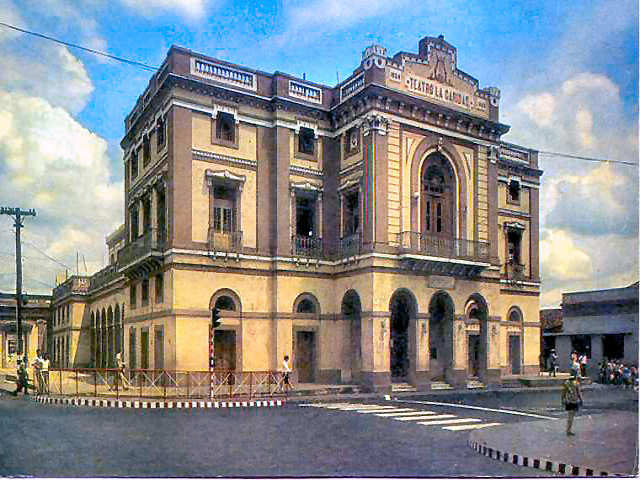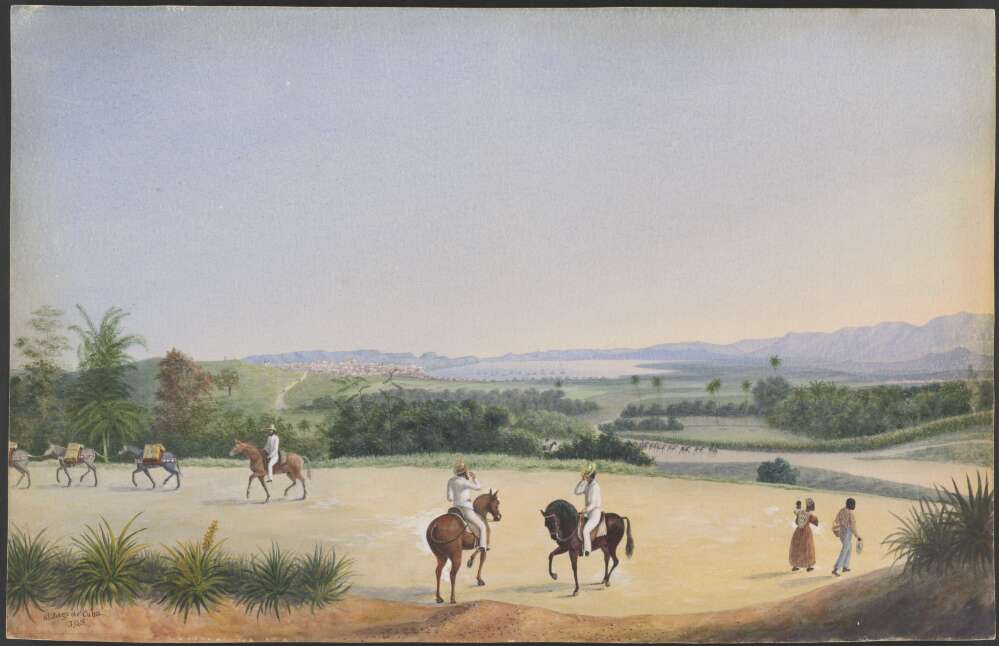|
Teatro De La Caridad
Teatro de La Caridad or Teatro La Caridad (Spanish for "Charity's Theater"), located in Santa Clara, is one of the few remaining colonial theatres in Cuba. It is a National Monument of Cuba. History Early history Teatro de La Caridad was built in 1885 and is one of The Eight Grand Theaters of Cuban Colonial era along with Teatro de la Marina in Santiago de Cuba 823 Milanes in Pinar del Río 838 Trinidad [1840], Principal in Camagüey [1850], Sauto in Matanzas [1863] and Terry in Cienfuegos [1890]. The theater was financed entirely by Marta Abreu, Marta Abreu de Estevez, a local and beloved philanthropist who contributed to the prosperity of the city, donating resources to many other projects. La Caridad is one of her greatest legacies. Engineer Don Herminio Leiva y Aguilera was in charge of the design of the building. Asked for more functionality Don Herminio came up with a structure with an auditorium for 500+ observers, a mini concert room, cafeteria, restaurant, barbersho ... [...More Info...] [...Related Items...] OR: [Wikipedia] [Google] [Baidu] |
Parque Vidal
Parque Vidal (also known by its previous names of Plaza Central and Plaza Mayor) is a park located in the center of Santa Clara, Cuba, covering an entire square block of the city. Due to its surrounding architecture, combining eclectic neo-classical and colonial-style buildings, as well as the large number of historic monuments dating from different historical periods, the park was designated as a National Monument in a ceremony in 1998. Monuments in the park The Glorieta gazebo in the center of the park, erected in 1911, still serves for weekly public concerts by the city's Philharmonic Band. North of the Glorieta is a bust of Leoncio Vidal, the War of Independence colonel who died on that spot fighting Spanish forces, and for whom the Park is named. Next to this bust is an obelisk, the first monument erected in the park, dedicated to the priest who migrated from the coastal town of Remedios with other families and founded the city. Between these monuments is a statue of “el ... [...More Info...] [...Related Items...] OR: [Wikipedia] [Google] [Baidu] |
Santa Clara, Cuba
Santa Clara is the capital city of the Cuban province of Villa Clara. It is centrally located in the province and Cuba. Santa Clara is the fifth-most populous Cuban city, with a population of nearly 250,000. History Santa Clara was founded by 175 people on July 15, 1689. 138 of them represented two large families already living in the area, who owned land next to the new city. The other 37 came from seven other families and included a priest and governor, all originating in the coastal city of San Juan de los Remedios. The population of Remedios had to choose between leaving their city, constantly being besieged by pirates, or staying. While most decided to stay, 37 people traveled south to the interior. On June 1, 1689, they arrived at a hill, joining two other families already present at the site. According to tradition, a mass was celebrated under a tamarind tree and Santa Clara was founded. Since then, the place under the tree has been known as ''Loma del Carmen'' ( ... [...More Info...] [...Related Items...] OR: [Wikipedia] [Google] [Baidu] |
Teatro La Caridad Sta Clara
Teatro may refer to: * Theatre * Teatro (band) Teatro, Italian for "theatre", is a vocal group signed to the Sony BMG music label. The members of Teatro are Jeremiah James, Andrew Alexander, Simon Bailey and Stephen Rahman-Hughes. Band members Jeremiah James Jeremiah James was born in upst ..., musical act signed to Sony BMG * ''Teatro'' (Willie Nelson album), 1998 * ''Teatro'' (Draco Rosa album), 2008 {{disambiguation ... [...More Info...] [...Related Items...] OR: [Wikipedia] [Google] [Baidu] |
Teatro La Caridad
Teatro de La Caridad or Teatro La Caridad (Spanish for "Charity's Theater"), located in Santa Clara, is one of the few remaining colonial theatres in Cuba. It is a National Monument of Cuba. History Early history Teatro de La Caridad was built in 1885 and is one of The Eight Grand Theaters of Cuban Colonial era along with Teatro de la Marina in Santiago de Cuba 823 Milanes in Pinar del Río 838 Trinidad [1840], Principal in Camagüey [1850], Sauto in Matanzas [1863] and Terry in Cienfuegos [1890]. The theater was financed entirely by Marta Abreu, Marta Abreu de Estevez, a local and beloved philanthropist who contributed to the prosperity of the city, donating resources to many other projects. La Caridad is one of her greatest legacies. Engineer Don Herminio Leiva y Aguilera was in charge of the design of the building. Asked for more functionality Don Herminio came up with a structure with an auditorium for 500+ observers, a mini concert room, cafeteria, restaurant, barbersho ... [...More Info...] [...Related Items...] OR: [Wikipedia] [Google] [Baidu] |
Spanish Language
Spanish ( or , Castilian) is a Romance languages, Romance language of the Indo-European language family that evolved from colloquial Latin spoken on the Iberian peninsula. Today, it is a world language, global language with more than 500 million native speakers, mainly in the Americas and Spain. Spanish is the official language of List of countries where Spanish is an official language, 20 countries. It is the world's list of languages by number of native speakers, second-most spoken native language after Mandarin Chinese; the world's list of languages by total number of speakers, fourth-most spoken language overall after English language, English, Mandarin Chinese, and Hindustani language, Hindustani (Hindi-Urdu); and the world's most widely spoken Romance languages, Romance language. The largest population of native speakers is in Mexico. Spanish is part of the Iberian Romance languages, Ibero-Romance group of languages, which evolved from several dialects of Vulgar Latin in I ... [...More Info...] [...Related Items...] OR: [Wikipedia] [Google] [Baidu] |
Cuba
Cuba ( , ), officially the Republic of Cuba ( es, República de Cuba, links=no ), is an island country comprising the island of Cuba, as well as Isla de la Juventud and several minor archipelagos. Cuba is located where the northern Caribbean Sea, Gulf of Mexico, and Atlantic Ocean meet. Cuba is located east of the Yucatán Peninsula (Mexico), south of both the American state of Florida and the Bahamas, west of Hispaniola (Haiti/Dominican Republic), and north of both Jamaica and the Cayman Islands. Havana is the largest city and capital; other major cities include Santiago de Cuba and Camagüey. The official area of the Republic of Cuba is (without the territorial waters) but a total of 350,730 km² (135,418 sq mi) including the exclusive economic zone. Cuba is the second-most populous country in the Caribbean after Haiti, with over 11 million inhabitants. The territory that is now Cuba was inhabited by the Ciboney people from the 4th millennium BC with the Gua ... [...More Info...] [...Related Items...] OR: [Wikipedia] [Google] [Baidu] |
Santiago De Cuba
Santiago de Cuba is the second-largest city in Cuba and the capital city of Santiago de Cuba Province. It lies in the southeastern area of the island, some southeast of the Cuban capital of Havana. The municipality extends over , and contains the communities of Antonio Maceo, Bravo, Castillo Duany, Daiquirí, El Caney, El Cobre, El Cristo, Guilera, Leyte Vidal, Moncada and Siboney. Historically Santiago de Cuba was the second-most important city on the island after Havana, and remains the second-largest. It is on a bay connected to the Caribbean Sea and an important sea port. In the 2012 population census, the city of Santiago de Cuba recorded a population of 431,272 people. History Santiago de Cuba was the fifth village founded by Spanish conquistador Diego Velázquez de Cuéllar on July 25, 1515. The settlement was destroyed by fire in 1516, and was immediately rebuilt. This was the starting point of the expeditions led by Juan de Grijalba and Hernán Cortés to the ... [...More Info...] [...Related Items...] OR: [Wikipedia] [Google] [Baidu] |
Pinar Del Río
Pinar del Río is the capital city of Pinar del Río Province, Cuba. With a population of 139,336 (2004) in a municipality of 190,332, it is the 10th-largest city in Cuba. Inhabitants of the area are called ''Pinareños''. History Pinar del Río was one of the last major cities in Cuba founded by the Spanish, on September 10, 1867. The city and province was founded as ''Nueva Filipinas'' (New Philippines) in response to an influx of Asian laborers coming from the Philippine Islands to work on tobacco plantations. Pinar del Río's history begins with the Guanahatabey, a group of nomadic Indians who lived in caves and procured most of their livelihood from the sea. Less advanced than the other indigenous natives who lived on the island, the Guanahatabey were a peaceful and passive race whose culture came about largely independently of the Taíno and Siboney cultures further east. The Guanahatabey were extinct by the time of the Spanish arrival in 1492; little firsthand document ... [...More Info...] [...Related Items...] OR: [Wikipedia] [Google] [Baidu] |




